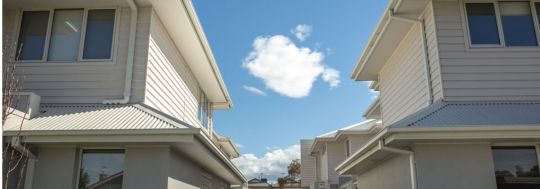Residential home loans

If you’re in the market to buy a property for you or your family, and you plan to live there and make it into a home, then you may need to apply for a residential home loan to help you make the purchase.
In this article, we’ll explain what residential home loans are and how they work, as well as consider the different types of loans that are available.
What is a residential home loan?
A residential home loan is a home loan that exists for people who want to purchase a property and then live there as owner occupiers. They can also be used by owner occupiers to conduct major renovations on a property they already live in. In this way, residential home loans are different from investor home loans, which are intended for people who purchase a property and rent it out in order to earn an income.
What kind of residential home loans are available?
In general terms, there are three kinds of residential home loans available to owner occupiers – fixed rate loans, variable rate loans, and split loans, which are a combination of the first two. One of the main distinctions between fixed and variable rate loans is in the interest rate, which remains the same with a fixed residential home loan, and can fluctuate with a variable one.
What is a fixed residential home loan?
A fixed residential home loan can allow an owner occupier purchasing a new property to lock in or ‘fix’ their interest rate for a set period of time, be it one year, two years, five years or longer. If you choose a fixed rate home loan, your interest rate will not go up or down, irrespective of how interest rates move in the market.
A key advantage of fixed residential home loans is the certainty of knowing that your interest rate will remain the same for whatever period you decide to set it, even if interest rates rise in the market. The comparison rate for your home loan, which combines the interest rate with most fees and charges, may be helpful for you to consider too. A key disadvantage of fixed rate loans is that they tend to come with fewer features than their variable counterparts, and are more restrictive in their terms.
For example, you generally cannot make additional repayments on a fixed rate home loan without a cost penalty. Similarly, if you wish to break a fixed rate home loan early – whether you are selling your property or refinancing the loan – you will typically be charged a break fee by your lender.
What is a variable residential home loan?
A variable residential home loan is one in which the interest rate is not set. Instead, it can go up or down over the term of the loan, meaning you could end up paying more or less. Generally speaking, the Reserve Bank of Australia (RBA) board will meet most months to set the official cash rate, and lenders will typically respond to this by moving their interest rates up or down. The RBA’s decisions are not the only factor affecting variable rates, though, as lenders may also change rates based on market forces and their own commercial considerations.
A key advantage of variable rate home loans is the fact that they often come with a variety of features, including offset accounts and redraw facilities. They also typically allow you to make additional repayments over and above your normal monthly repayment, meaning that you can potentially pay down the balance of your home loan more quickly.
One key disadvantage is the fact that the interest rate on variable residential home loans can go up if your lender chooses to raise rates, meaning you could end up paying much more in interest than when you took out the loan. If you want the certainty of knowing how much your repayments will be each month, or you are wary of rate rises, this may not be desirable for you.
What is a split residential home loan?
A split residential home loan allows you to combine the features of both a fixed and variable rate residential home loan at a percentage split that you find appealing. Say you want the certainty of knowing that a particular portion of your loan is at a fixed rate, while also having a variable portion that will allow you to have access to extras like an offset account, redraw facility and the ability to make additional repayments. In this instance, a split loan may be desirable.
If you opt for a split home loan, it is important to consider how great a percentage of the loan will be at a variable rate, because if your lender raises interest rates, then you may end up paying higher interest on this portion of the loan.
What deposit do you need for a residential home loan?
The exact amount of the deposit you need to buy a home will depend on the purchase price. However, it is important to consider the loan to value ratio (LVR) of a home loan when calculating the deposit. The lender will typically calculate the LVR on your home loan by dividing the loan amount by an independent valuation of the property you are buying. The LVR of a loan represents the maximum amount that a lender is willing to lend you to purchase a property, so if the maximum LVR is 80%, this means you will need a deposit of 20% of the purchase price.
It may be possible to purchase a home with no deposit, although the Australian Prudential Regulation Authority (APRA) has tightened rules around home lending, in a move anticipated to reduce the maximum borrowing capacity for average Australian borrowers.
The size of your home deposit can have a big impact on what you’ll be able to borrow, as well as the overall costs of your mortgage. The RBA says that borrowing more than you can really afford is a risk for falling into arrears and defaulting on a mortgage. So, to avoid mortgage stress and going into negative equity, you may like to carefully consider different factors that may influence your capacity to repay a residential home loan.
It is also worth keeping in mind that if your deposit for a home is below a certain threshold – often 20% of the purchase price, although there can be exceptions – some lenders will charge lenders mortgage insurance (LMI). Lenders generally charge LMI if they feel that a loan may be risky, in order to protect themselves in the event that the borrower is unable to meet their required repayments.
Related: How to apply for a home loan
How do you compare residential home loans?
If you’re in the market for a residential home loan, you can compare home loans with Canstar. Each year, Canstar gives out Home Loan Awards to the lenders that offer outstanding value to Aussie home buyers, so you could also consider this year’s winners to find a provider who might offer you a favourable home loan.
Consider the Target Market Determination (TMD) before making a purchase decision. Contact the product issuer directly for a copy of the TMD.
Compare Home Loans (Refinance with variable rate only) with Canstar
If you’re currently considering a home loan, the comparison table below displays some of the variable rate home loans on our database with links to lenders’ websites that are available for homeowners looking to refinance. This table is sorted by Star Rating (highest to lowest), followed by comparison rate (lowest to highest). Products shown are principal and interest home loans available for a loan amount of $500,000 in NSW with an LVR of 80% of the property value. Consider the Target Market Determination (TMD) before making a purchase decision. Contact the product issuer directly for a copy of the TMD. Use Canstar’s home loans comparison selector to view a wider range of home loan products. Canstar may earn a fee for referrals.
The comparison rate for all home loans and loans secured against real property are based on secured credit of $150,000 and a term of 25 years.
^WARNING: This comparison rate is true only for the examples given and may not include all fees and charges. Different terms, fees or other loan amounts might result in a different comparison rate.
 Owner occupied
Owner occupied
 20% min deposit
20% min deposit
 Redraw facility
Redraw facility

Up to $2,500 when you refinance with a Greater Bank home loan. Minimum loan amounts and LVR restrictions apply. Offer available until further notice. See provider website for full details. Exclusions, terms and conditions apply.
 Owner occupied
Owner occupied
 20% min deposit
20% min deposit
 Redraw facility
Redraw facility
 Owner occupied
Owner occupied
 10% min deposit
10% min deposit
 Redraw facility
Redraw facility

Up to $4,000 when you take out a IMB home loan. Minimum loan amounts and LVR restrictions apply. Offer available until further notice. See provider website for full details. Exclusions, terms and conditions apply.
 Owner occupied
Owner occupied
 20% min deposit
20% min deposit
 Redraw facility
Redraw facility
 Owner occupied
Owner occupied
 10% min deposit
10% min deposit
 Redraw facility
Redraw facility
Canstar is an information provider and in giving you product information Canstar is not making any suggestion or recommendation about a particular product. If you decide to apply for a home loan, you will deal directly with a financial institution, not with Canstar. Rates and product information should be confirmed with the relevant financial institution. Home Loans in the table include only products that are available for somebody borrowing 80% of the total loan amount. For product information, read our detailed disclosure, important notes and additional information. *Read the comparison rate warning. The results do not include all providers and may not compare all the features available to you.
Home Loan products displayed above that are not “Sponsored or Promoted” are sorted as referenced in the introductory text followed by Star Rating, then lowest Comparison Rate, then alphabetically by company. Canstar may receive a fee for referral of leads from these products.
When you click on the button marked “Enquire” (or similar) Canstar will direct your enquiry to a third party mortgage broker. If you decide to find out more or apply for a home loan, you can provide your details to the broker. You will liaise directly with the broker and not with Canstar. When you click on a button marked “More details” (or similar), Canstar will direct your enquiry to the product provider. Canstar may earn a fee for referral of leads from the comparison table above. See How We Get Paid for further information.
Cover image source: By Shuang Li/Shutterstock.com.
This article was reviewed by our Finance and Lifestyle Editor (former) Shay Waraker and Sub Editor Jacqueline Belesky before it was updated, as part of our fact-checking process.

Alasdair Duncan is Canstar's Content Editor, specialising in home loans, property and lifestyle topics. He has written more than 500 articles for Canstar and his work is widely referenced by other publishers and media outlets, including Yahoo Finance, The New Daily, The Motley Fool and Sky News. He has featured as a guest author for property website homely.com.au.
In his more than 15 years working in the media, Alasdair has written for a broad range of publications. Before joining Canstar, he was a News Editor at Pedestrian.TV, part of Australia’s leading youth media group. His work has also appeared on ABC News, Junkee, Rolling Stone, Kotaku, the Sydney Star Observer and The Brag. He has a Bachelor of Laws (Honours) and a Bachelor of Arts with a major in Journalism from the University of Queensland.
When he is not writing about finance for Canstar, Alasdair can probably be found at the beach with his two dogs or listening to podcasts about pop music. You can follow Alasdair on LinkedIn.
- What is a residential home loan?
- What kind of residential home loans are available?
- What is a fixed residential home loan?
- What is a variable residential home loan?
- What is a split residential home loan?
- What deposit do you need for a residential home loan?
- How do you compare residential home loans?
The comparison rate for all home loans and loans secured against real property are based on secured credit of $150,000 and a term of 25 years.
^WARNING: This comparison rate is true only for the examples given and may not include all fees and charges. Different terms, fees or other loan amounts might result in a different comparison rate.
 Owner occupied
Owner occupied
 20% min deposit
20% min deposit
 Redraw facility
Redraw facility
Try our Home Loans comparison tool to instantly compare Canstar expert rated options.
The comparison rate for all home loans and loans secured against real property are based on secured credit of $150,000 and a term of 25 years.
^WARNING: This comparison rate is true only for the examples given and may not include all fees and charges. Different terms, fees or other loan amounts might result in a different comparison rate.






